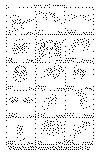OBEY. Make the sign for LISTEN.
OCEAN. Make the signs for WATER and BIG.
OFFICER. Make the sign for CHIEF.
OFTEN (MANY TIMES, REPEAT). Hold left forearm horizontally in front of left breast, pointing to front; then with right index touch left forearm several times commencing at wrist and passing upwards towards elbow.
OJIBWAY. See CHIPPEWA.
OLD (meaning: walking with a stick). Hold closed right hand, back to right, twelve inches in front of right shoulder, at height of breast; move hand upwards, to front, downwards and back to first position in a curve. Repeat motion.
OPPOSITE. Point both extended index fingers toward each other, at same height, other fingers and thumbs closed.
OSAGE-Indian (meaning: shaved heads). Bring backs of extended hands alongside of head, fingers pointing to rear; move hands downwards as though cutting the hair with lower edges of hands. Repeat this.
OTTER (meaning: decorating the hair). Hold right hand near top of right ear, thumb, index and second fingers extended together; lower the hand while making a small spiral with tips of fingers. There is a general custom among all plains Indians of decorating the hair with strips of otter skin.
OUTSIDE. Make sign to show whether outside of teepee, house or camp; then with left hand still in position make sign for HERE with right hand, beyond or outside of the left hand.
OVER. Make the sign for ACROSS.
OVERTAKE. Extend left flat hand with palm outwards, fingers pointing to front and up; hold right 1 hand near breast, palm outwards, index pointing front and up; till it touches left.
OWL (meaning: big eyes). Make sign for BIRD; then make circles of thumbs and indexes of both hands and place them in front of eyes.
OWN. Make the sign for POSSESSION.
P
PACK. Hold partly compressed left hand in front of body, back out; then with partly compressed right hand pat upper surface of left; then pat back of left; then reverse and in same manner pat Tight hand with left. This represents loading a pack animal.
PADDLE. Make the sign for BOAT, and indicate use of paddle.
PAINT. With fingers extended rub the cheeks and front of face with palm of right hand.
PALSY. Bring the hands close to breast, back up, then shake them with a quivering motion.
PARADE. Make sign for WHITE MAN, for SOLDIER, and for WALK. Sometimes add RIDING HORSE BACK, and GO.
PART. If one-half, make sign for HALF; if more or less indicate accordingly.
PARTNER. Make sign for BROTHER. Indians seem averse to partnership, but often adopt a man as friend or brother.
PAST. (Sense of time-meaning time behind.) Make the sign for BEFORE.
PAWNEE (meaning: Wolf). Make the sign for INDIAN, then hold right 2 hand, fingers extended, close to right shoulder, palm outwards; carry hand slightly upwards and six inches to front.
PAYMASTER. Make the signs for MONEY and CHIEF.
PEACE. Clasp the hands in front of body, with back of left hand down.
PEAK. Compress fingers of right hand tightly together, cone shape; then raise hand in front of body, back outwards.
PEOPLE. Right index, shoulder high, moving up and down as shown. Have seen Indians use both 5 hands, near breast, backs out.
PERHAPS (meaning: two hearts). Hold right 2 hand over heart, pointing to left, fingers separated; then by forearm movement roll the hand back and forth. When expressing many conflicting emotions or many doubts, vibrate or roll the extended 5 hand. This would represent deep consideration.
PHONOGRAPH. With right hand make as though to wind it up; then show turning disk; then make signs for LISTEN, and GOOD. (A flexible modern sign, well understood by Indians.)
PICKET--To picket a horse (meaning: to drive picket pin in the ground). Make the sign for HORSE, for TIMBER; then bring closed left hand, thumb up, in front of body, and strike it a few times with closed right hand.
